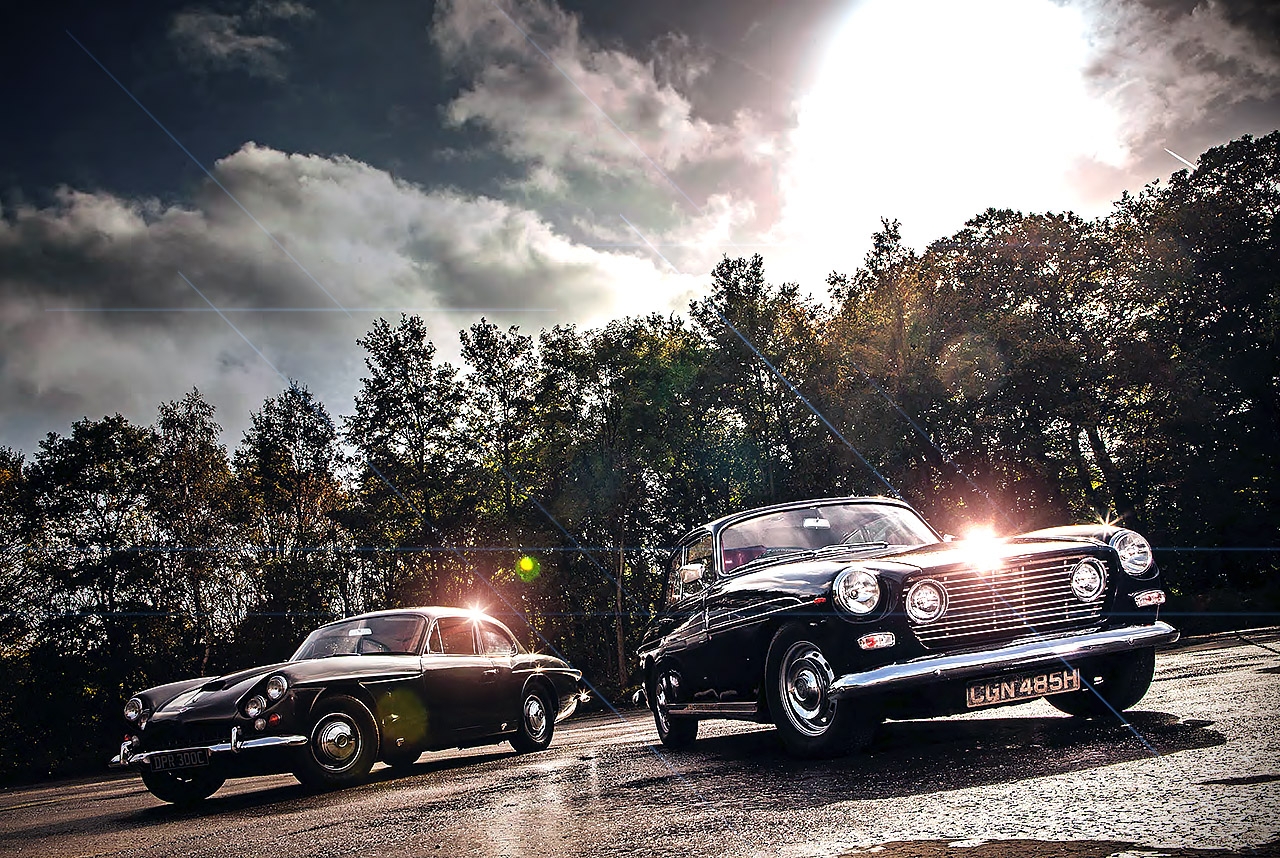
Britain’s gentlemanly GTs Jensen C-V8 battles Bristol 410. How to be a rebellious gentleman. Jensen and Bristol may have not have been hip in the 1960s, but neither were they square. James Elliott pitches C-V8 against 410. Photography Tony Baker.
The 1950s may have presented a cultural earthquake, with the youth stepping out of the shadows of their parents and turning the world into colour, but the aftershocks continued right through the ’60s as that generation grew up. Or more to the point, didn’t – and neither did those who were a few years too old to properly go off the rails in the 1950s.
Men woke up with a start from the traditional sleepwalk towards middle-age and, as family circumstances forced the sidescreen TRs and Austin-Healeys to be cast aside, those of a wealthier disposition found themselves not quite ready to settle into the Oxbridges that their parents might consider a “prudent” choice.
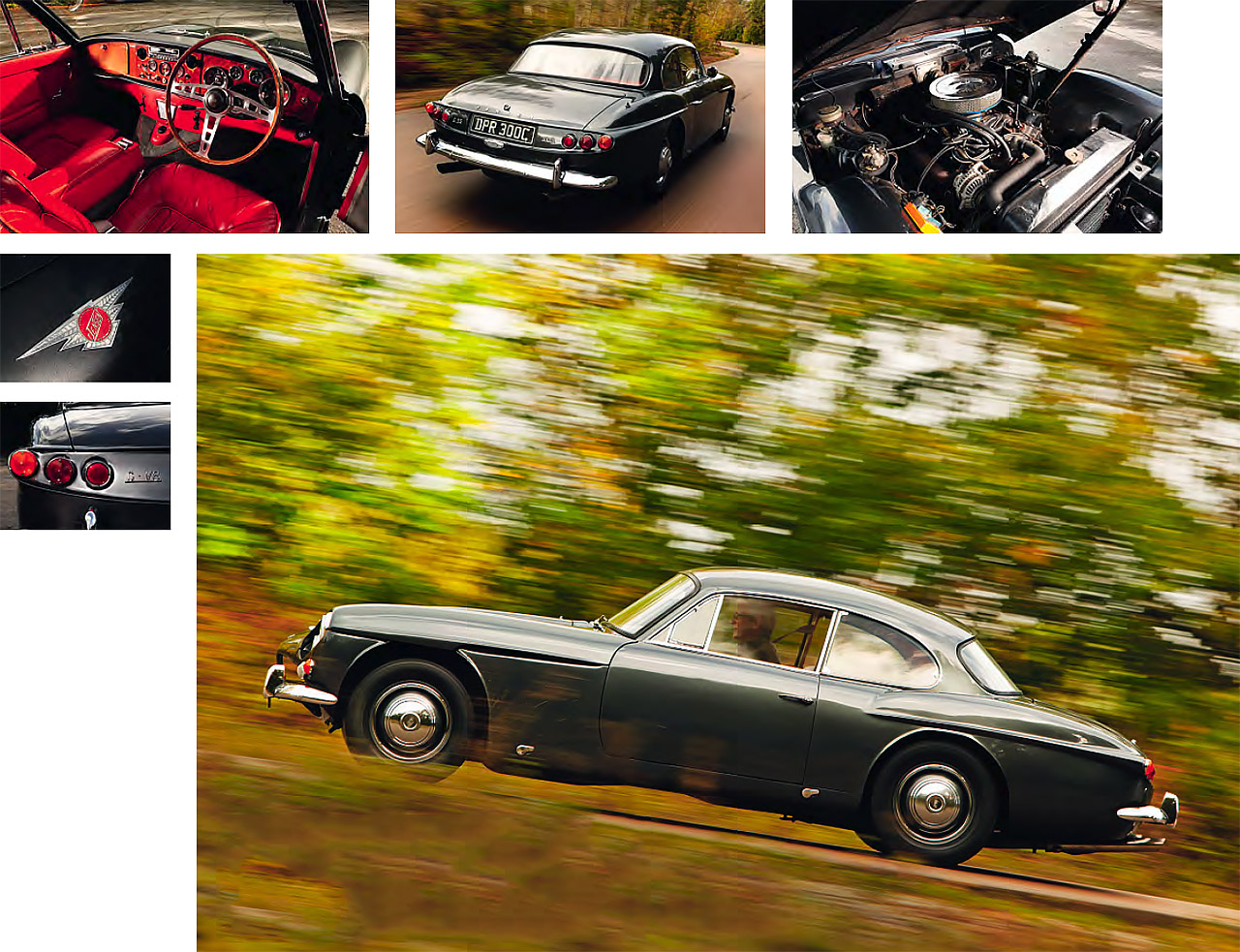
Clockwise, from right: Neale’s styling is more rakish than that of the Bristol; triple rear lights; ‘flash’ badge; cosseting seats; strong performance from Chrysler 6.3-litre V8 powerplant.
GTs were all the rage but many of them – especially those ‘flash Harry’ Italian jobs – were rather unbecoming of men of a certain status. Hence two British manufacturers that themselves enjoyed a certain status in the motoring firmament set about providing the new captains of industry with something exciting, but also satisfying their more mundane demands via proper back seats and capacious boots. Cars that reflected their standing and yet, in the driving at least, selfishly staved off the ageing process.
‘BEST OF ALL, THE JENSEN DOES EVERYTHING WITH A BEWITCHING SOUNDTRACK’
They were priced according to that standing, too. If you thought that the Jensen C-V8 was eye-wateringly expensive at more than twice the price of a top-spec Jaguar Mk2, then the Bristol 410, at more than half as much again, would have bought you the moon on a stick. With sprinkles. At first sight, the Bristol would seem to project this obscene cost rather less forcefully than the Jensen. Coming in the middle of the ‘spot the difference’ third generation of Bristols – spanning 408 to 411, having morphed out of the somewhat less popular 407 – the 410 seems staid from a distance, but its delicacy and subtlety mask the clean modernity of it.
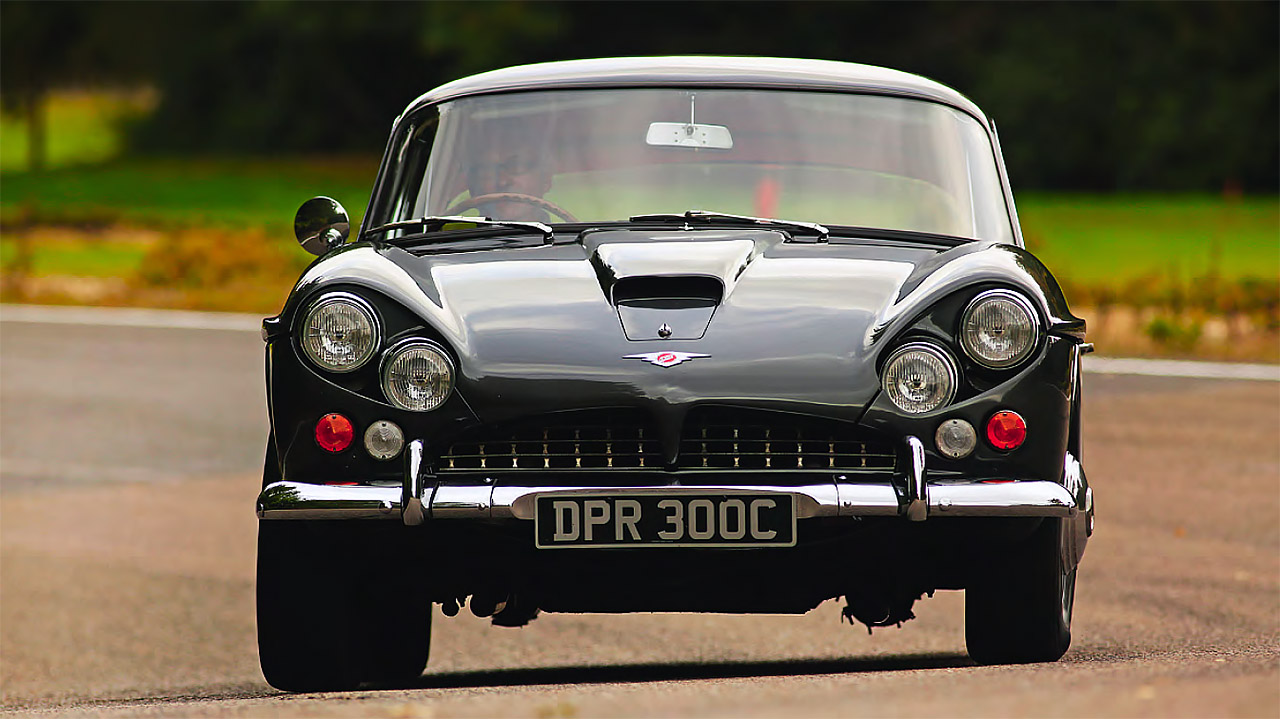
Clockwise, from below: C-V8 can be cornered more aggressively than the Bristol; heavily sculpted rear seats; Jensen also rides on 15in steel wheels.
The hefty C-pillar and bulbous rear screen give it a very upright mien, but when you analyse it more closely there are myriad touches to feast on, from the obvious – the lamps inset into the grille – to the more graceful, such as the smoothly dipping bonnet line, the paired chrome strakes that disrupt the slab-sided profile and those embryonic fins at the rear. The styling exudes a knowing yet restrained confidence. The most curious thing about the Bristol is that, as was Tony Crook’s wont, it is a two-door. That seems totally at odds with the rest of its styling and character, but it is not insurmountable. In fact, a 410 is the only two-door car that I have ever seen chauffeur-driven, when one parked up at Heathrow and a glamorous lady dressed like Cruella de Vil – complete with cigarette holder – folded herself into the rear before the fully uniformed ‘Parker’ loaded bag after bag of luggage into the vast boot.
‘THE BRISTOL’S STYLING EXUDES A KNOWING YET RESTRAINED CONFIDENCE’
You can understand her thinking. With a near-flat floor, a plump rear seat surrounded with high-quality chrome details, plus hectares of space, it must have been a very amenable place in which to complete The Times crossword. Even so, it made for a particularly incongruous sight in the mid-1980s, almost as much of an anachronism as the Jensen C-V8 must have seemed in the early 1960s. Few manufacturers can have so thoroughly and dramatically changed direction as Jensen did when it launched the exciting new 541 – a car that would help to define the company’s future – in 1953.
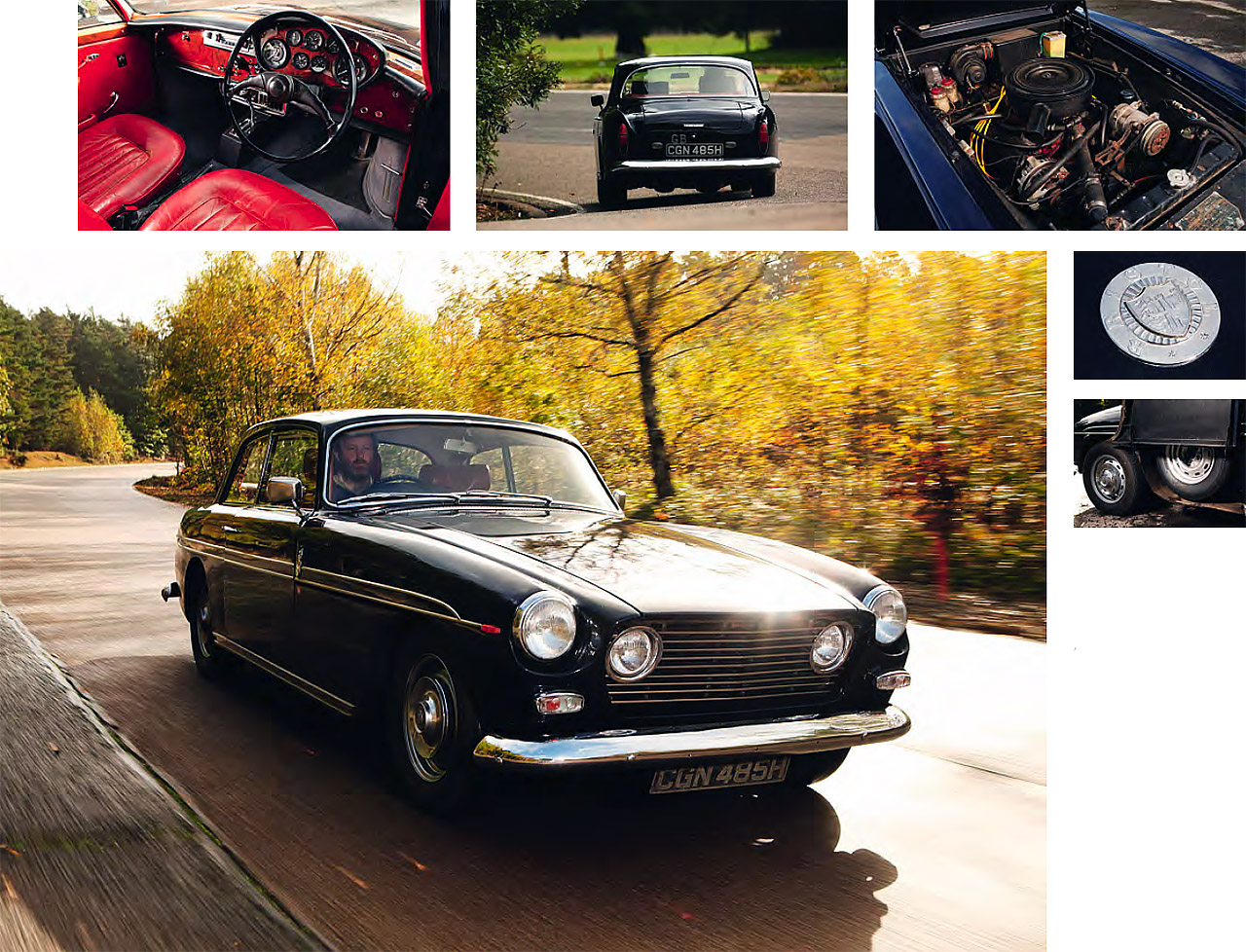
Clockwise, from left: changes over 409 included part-recessed headlamps; comfortable cabin; 410 errs towards understeer; smooth V8; badge reflects city’s heritage; signature spare wheel location.
It wasn’t just Eric Neale’s thoroughly modern design that consigned stately stock such as the first-generation Interceptor to history, but the use of glassfibre for the body. Then there were triple carbs for the 150bhp Austin engine, rackand- pinion steering and disc brakes all round.
Production numbers of a smidgen over 500 cars might not sound earth-shattering, but compare that to fewer than 100 of the original Interceptor and the single-figure run of the PW. The 541 and C-V8 were the chrysalis of Jensen turning from truck-maker, coachbuilder and very smallproduction car manufacturer into a serious player, racking up sales in the several thousands. It’s worth noting here that, until the 411 moved close to 300 units, Bristol’s sales figures were almost wilfully going in the opposite direction, with just 82 410s finding homes.
As with its predecessor, the C-V8 sold around 500 units (more than 300 survive) and was based on the same PW chassis, but was clothed with an aggressive plastic suit that wasn’t to all tastes. Quite apart from the slanted quad headlamps – differently sized on early cars – it is all extreme curves, speed strakes and low-riding menace. Overall, though, and especially in profile, it is very nicely balanced and offers a deceptively roomy cabin. Not that anyone would ever want to be chauffeur-driven in a C-V8, but thanks to the well-defined sunken seats and decent-height roof, it is a surprisingly comfortable place to be. In fact, due to reduced wheelarch ingress, there seems to be more rear space in the C-V8 than in its successor, the Interceptor.
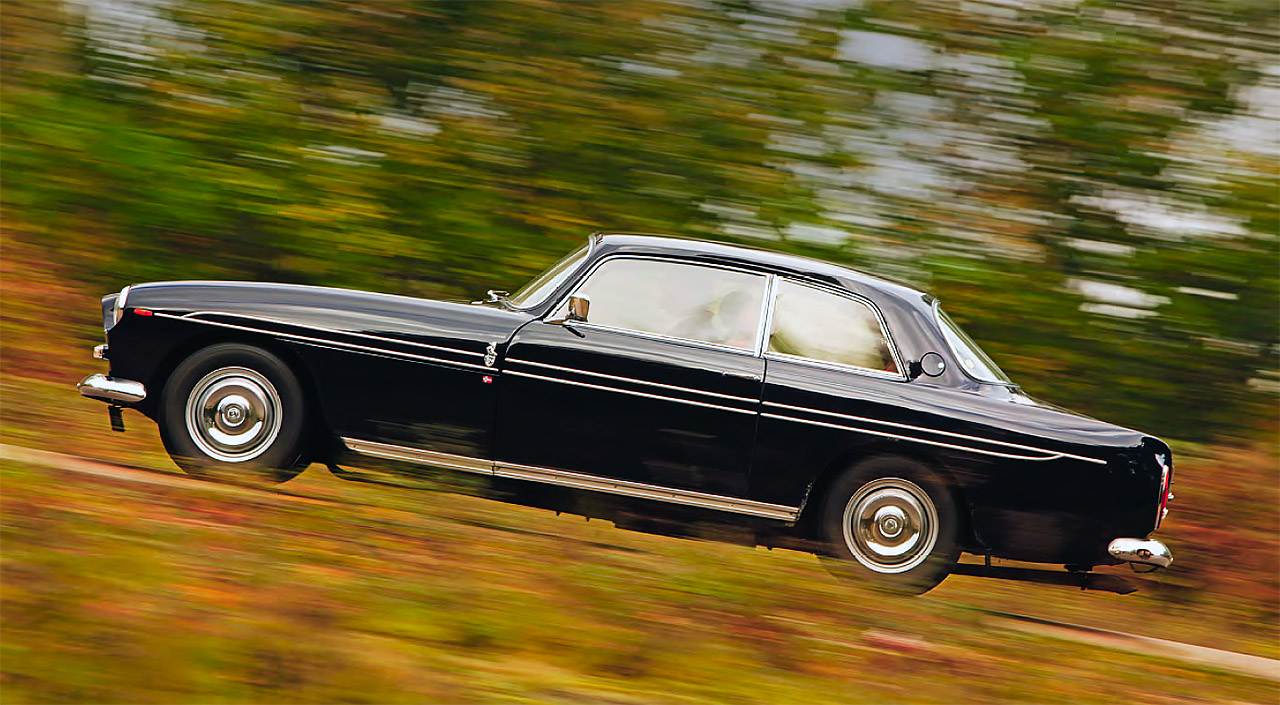
Clockwise, from below: dipping bonnet line eases the Bristol’s boxy profile; well-padded rear seats are very accommodating for a two-door design; 15in steel wheels.
Rather more so than the Bristol, however, the Jensen is focused on the driver. You sit low and nicely clamped by the well-bolstered seat, the door a little closer to your shoulder than is natural. Some of the quality touches – such as the lovely chromework around the quarterlight – enhance the feeling that this was an extremely expensive car in its day. The sensations are of sporting security and comfort rather than airiness, but it is in no way claustrophobic.
Having the gears on the stalk leaves a sparse transmission tunnel, but the dash – a lovely walnut effort on this SIII replacing the Laminex of earlier iterations – is packed with randomly spread toggles and dials. In front of you is a huge (to offset the lack of power steering) three-spoke wheel, a 160mph speedometer, oil pressure and temperature gauges, plus a 6000rpm rev counter with the red zone starting at 5100rpm.
It was beneath the bonnet that there was another major change from the 541. Gone was the venerable 4-litre Austin motor and in came a brash, powerful – and thirsty – invader from the colonies. The Chrysler V8, initially offered in 5916cc and then 6276cc form, doubled horsepower and gave the new Jensen a dangerous edge. A few had manual gearboxes, but the three-speed TorqueFlite ruled the run.
Fire it up and the aggressive double heartbeat stops well short of obnoxious. Move it into Drive and press the heavy throttle to get the Edelbrock gurgling. Initially that big wheel, obscuring a good part of the already small windscreen, is a slight annoyance, but as you press on all your focus is diverted away from such trivialities. In contrast to the Bristol, the Jensen feels quick at any speed, but it isn’t as feral as the specs and looks suggest. Its ride is about perfect – any harshness nullified by the padded seats – and the handling is absolutely neutral at what should be quite dramatic speeds. Even when you push it too hard on a damp corner, it slides long before it snaps. With its low centre of gravity and squarer ratio of track to wheelbase, it will allow you to throw it around like a 1950s roadster – when you get the throttle balance right. Best of all, it does everything with a bewitching soundtrack.
A smaller wheel would transform the experience at speed, and with lighter throttle response the car could be a whole lot more lively. The only difference between the C-V8 as a GT and the C-V8 as an out-and-out sports car is set-up.
The Bristol will never be a sports car. In the 410 you sit upright in a commanding driving position, the huge front seats high and proud below enormous, original but non-standard headrests that do not detract one jot from the sense of airy spaciousness. You lord it over your surroundings, gazing at the well-organised, more distant dashboard and soaking up such luxuries as (again, original but non-standard) air-conditioning and electric windows. The car is so perfectly and precisely what it set out to be that you shouldn’t change a thing.
As a driving machine, the Jensen is on paper more sporting, more taut, but the Bristol is utterly sublime as a wafter with some serious – and surprising – go. If anything, it feels lighter on the road than the Jensen. It pulls up the sharper of these all-disc cars, too, and the ride is utterly cosseting yet domineering.
But when you do boot it, the 410 is mindbogglingly zippy for a car of this size. The smooth efficiency of the pick-up is like the difference between a standing and rolling start. It feels thoroughly planted, even on a damp surface, although plenty of tiny steering inputs are needed when driving hard and the Bristol reveals itself to be a gentle understeerer.
It is at such higher speeds that the differences between the two really come to light. In the Jensen you are more hunched and always totally involved. The way in which its seat secures you in place becomes a huge advantage as the lateral forces slide you around in the Bristol.
It is also the point at which the wonderful cruising ride of the Bristol starts to feel quite wallowy and, if you are being silly, you can provoke it to pitch into corners with an unnerving sense of uncertainty. The ZF steering box is wonderfully precise, but batton-twirlingly light through the two-spoke wheel, therefore robbing the car of feedback and sharpness of response when you most need them, having barrelled so inadvisedly quickly into a corner that the wheels and tyres have stopped talking to you.
It has to be said that both of these cars surprise. The Jensen is far more civilised than you would imagine, the Bristol (on demand) far less so. In the driving, at least, they are far less disparate than you would think. It is really only cultural perception that separates them. On the surface, the Jensen is overtly sending a message to the world, a cloak of rebellion for an edgier man who is keen for people to know that he will retain his individuality, and never be entirely subsumed by the burdens and responsibilities of adulthood.
The Bristol looks so much more, well, establishment. On the road, however, it turns your preconceptions on their head in its typically unflustered fashion. In many ways, that makes it the more revolutionary of the two.
Thanks to the Jensen Owners Club
THE OWNER
Sam Frost
“It’s all Martin Buckley’s fault,” says Wiltshire-based photographer Sam Frost, who bought his 410 after reading a group test of a 411, Rolls-Royce Silver Shadow and Mercedes 300SEL 6.3. There have been no regrets, however, and over the past 11 years he has racked up just shy of 60,000 miles in it. Frost has always been into classics. Many have come and gone, but the Bristol has stuck: “It makes you feel very grown up, but has the ability to surprise people, too. I was leaning towards something American before I read Buckley’s review. “I soon realised that you could get a much better 410 for the same money as a 411, plus you get a nicer interior as well. I went to see a cheap 410 with Andrew Blow, but ended up buying this one from him instead because of its history: it had been rebuilt by Spencer Lane-Jones as his own car. I’ve packed it with friends and driven it to Spain in the past. It’s very sensible – on the surface.” The only major problem Frost had was when he drove it into a trailer, forcing him to replace the wings with near-identical 411 items and explaining the almost imperceptibly different grille aperture.
John Staddon
Having had a costly experience with a Daimler V8-250, it took Staddon a long time to come back round to classic cars. Ironically, his first port of call was Bristol. He says: “I was interviewed by Tony Crook to see if I was suitable. Clearly to his mind I was not, and it was the most unpleasant afternoon of my life. I swore then that I would never own a Bristol! Three weeks later, I bought a Jensen C-V8.” For 14 years, it has been Staddon’s only car and, after initially setting him back a few thousand pounds to get it right, it has been practical and reliable for some 28,000 miles. It has great history, having been in the long-term ownership of late marque figurehead Lord Strathcarron: “The constant theme is that owner after owner spent money on it like it was going out of fashion. Thankfully, that hasn’t been the case during my time with it, but that could be down to me using a bit more than some of the previous keepers. It’s not what the car does as much as the owning of it: it’s completely taken over my social life!” Staddon is on the committee of a local car club and is also C-V8 registrar for the Jensen Owners’ Club.
{CONTENTPOLL [“id”: 10]}
| Car | Bristol 410 | Jensen C-V8 |
| Made in | GB | GB |
| Sold | 1967-1969 | 1962-1966 |
| Number built | 82 | 500 |
| Construction |
steel reinforced box-section with aluminium body on tubular frame |
steel chassis, glassfibre body |
| Engine | all-iron, overhead-valve 5211cc V8, single four-barrel Carter AFB3131S carburettor |
all-iron, overhead-valve 6276cc V8, single four-barrel Edelbrock carburettor |
| Max power (DIN) | 254bhp @ 4400rpm | 330bhp @ 4600rpm |
| Max torque (DIN) | 340lb ft @ 2800rpm | 425lb ft @ 2800rpm |
| Transmission | three-speed TorqueFlite automatic, driving rear wheels |
three-speed Torqueflite auto or four-speed manual, driving rear wheels |
| Suspension |
front independent by wishbones, coil springs, anti-roll bar and telescopic dampers rear rigid axle with longitudinal torsion bars, lower radius arms, Watt linkage and Armstrong Selectaride dampers |
front independent, by double wishbones, coil springs rear live axle, semielliptic leaf springs; lever-arm dampers f/r |
| Steering | power-assisted recirculating ball | rack and pinion |
| Wheels | ||
| Brakes | Girling discs, with servo | Dunlop discs, twin servos |
| Measurements | ||
| Length | 16ft 1 ½ in (4915mm) | 15ft 4 ½ in (4686mm) |
| Width |
5ft 8in (1727mm) |
5ft 7 ½ in (1714mm) |
| Height | 4ft 11in (1499mm) | 4ft 7in (1397mm) |
| Wheelbase | 9ft 6in (2896mm) | 8ft 9in (2667mm) |
| Weight | 3528lb (1600kg) | 3332lb (1511kg) |
| 0-62mph | 8.8 secs | 6.7 secs |
| Top speed | 132mph | 136mph |
| Mpg | 15 | 14 |
| Price new |
£5673 |
£3491 |
| Price now | from £25,000 | from £30,000 |





